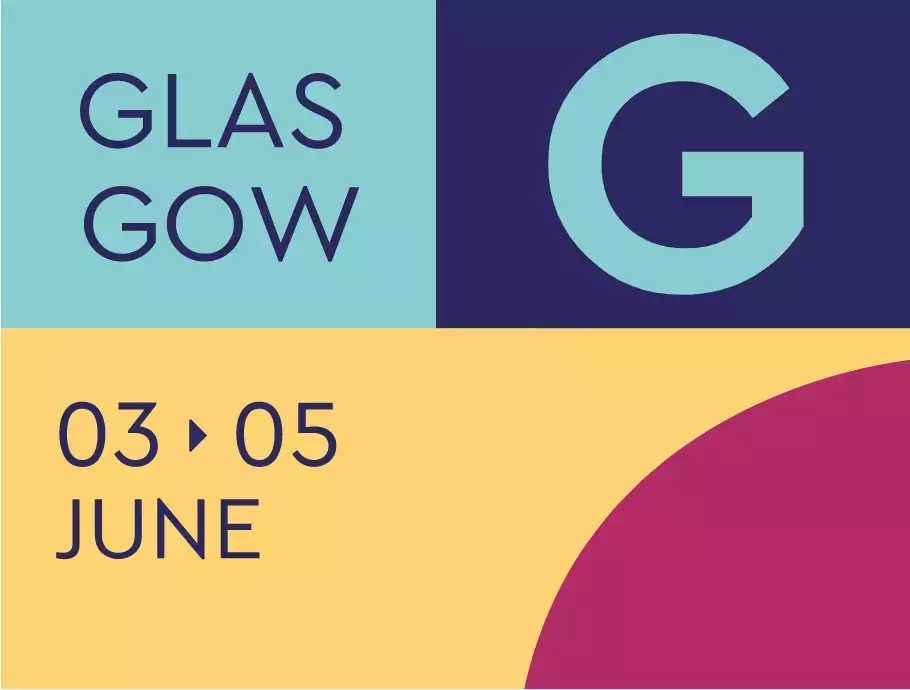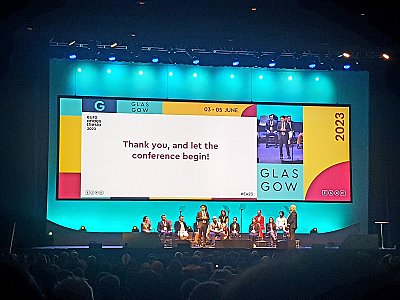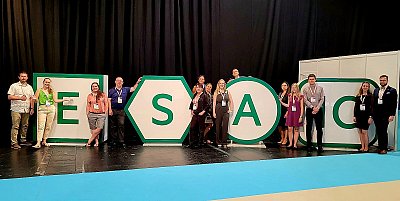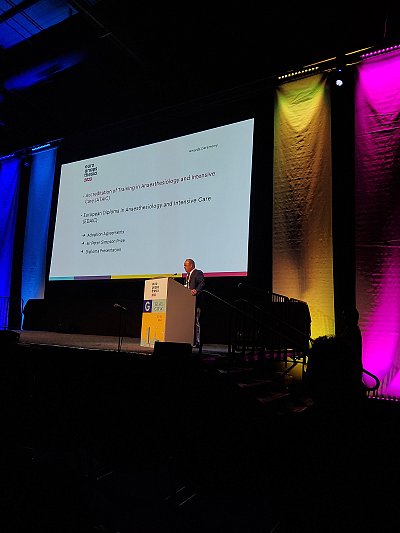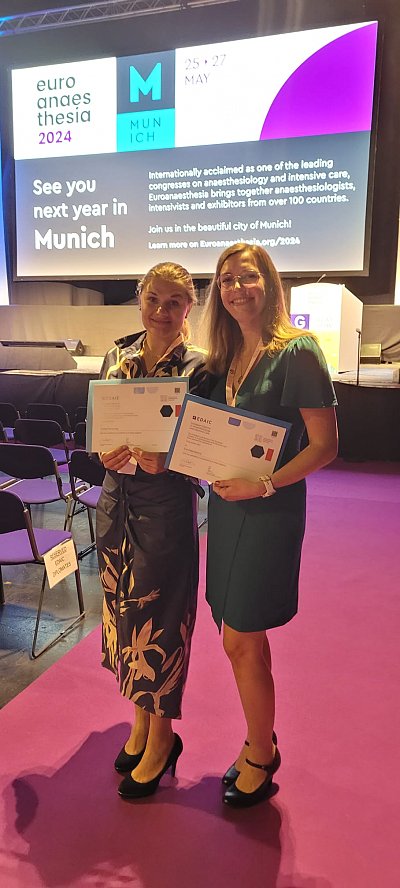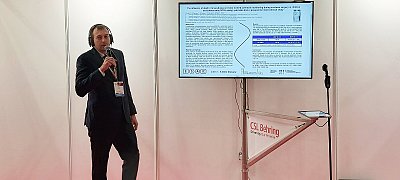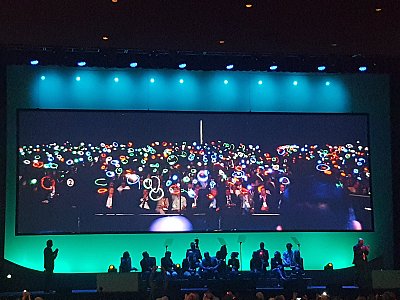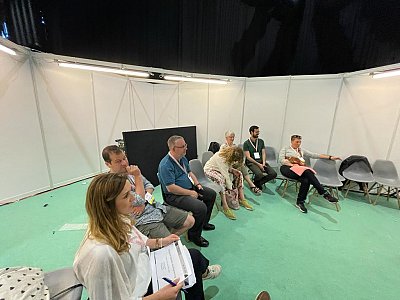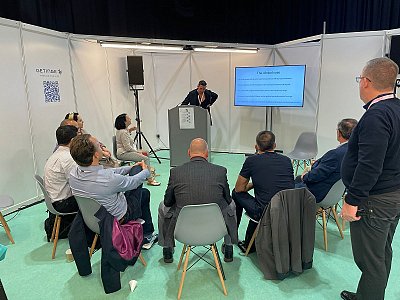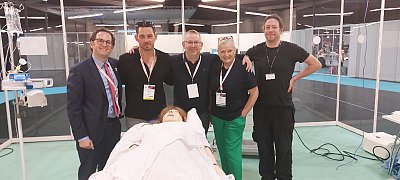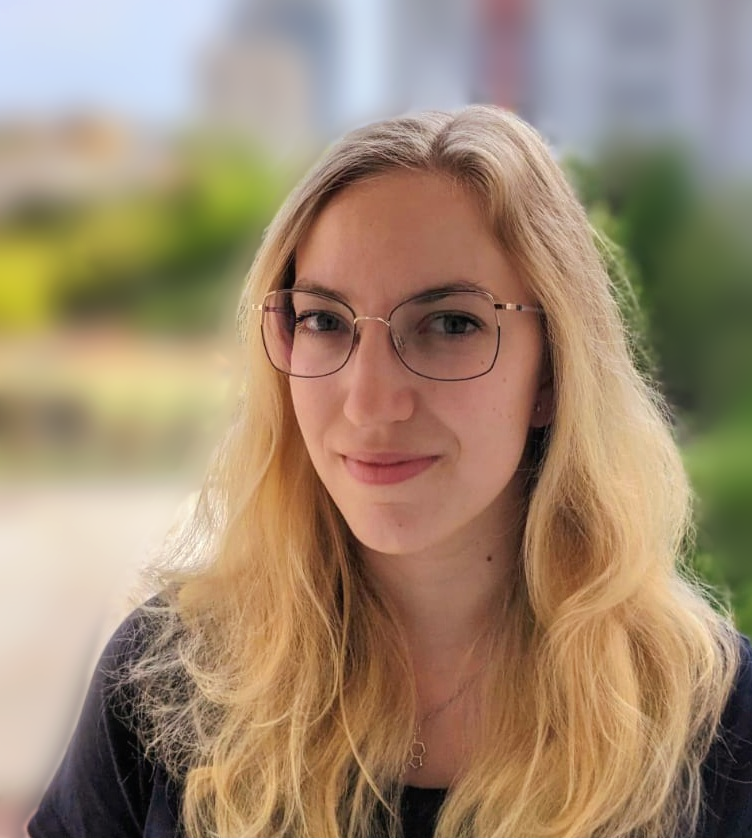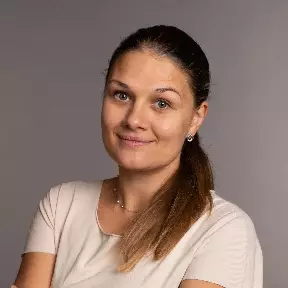The following text is a report from the members of the reporting team about the Euroanaesthesia 2023, the largest European anesthesiology congress held in Glasgow, Scotland from June 3rd to 5th, 2023.
Tamara Skříšovská
The congress in Glasgow started for me as a breathtaking experience with a sunset over the highlights and lakes around the city. I was very curious about how this year's congress would unfold. The program offered a lot of excellent speakers, workshops, and I also had the opportunity to actively participate by presenting a poster of our simulation study. The opening ceremony began with a tribute to the recently deceased Professor Paolo Pelosi, a legend who made significant contributions to our field, particularly in the area of ventilation. After the opening session, I attended several lectures on regional anesthesia, addressing topics such as preventing complications and discussing current controversial issues through pro-con debates. Meeting experts in the field was very enriching. Another area of interest for me was patient safety and learning about current projects in Europe and how to get involved to ensure safer patient care.
The second day started with parallel presentations in the poster section. It was nice to feel the support of colleagues. I believe all the speakers presented their projects very professionally, and our presentations were well-received and sparked interesting discussions, which is a positive sign of audience engagement. I attended presentations organized by the Trainee Committee, where they described the functioning and clinical application of saturation sensors, EEG, and nociception. These types of lectures always provide me with new information, and I often take away practical tips that I can use in my daily practice. It is also advantageous to explore the industry booths and learn about the latest technologies in our field, such as anesthesia machines or needles for regional blocks. There was even an interactive booth with bronchoscopy where you could complete tasks and search for treasure among LEGO figures, improving fine motor skills while using the bronchoscope and having fun.
The last day of the congress was mainly focused on receiving the EDAIC diploma. Together with Eva Klabusayová, we went through a long journey to successfully complete both parts of the exam. I would like to thank the support I received from the clinic's management and colleagues.
It is very demanding but forces you to study physiology, pathophysiology, pharmacology, and the specifics of our field. Like every year, the congress passed by quickly, and it is impossible to attend everything that interests me, but I will definitely try to watch the recommended lectures from my colleagues' recordings in the evenings. It was great to be part of the Czech delegation, and I thank everyone who made my experience enjoyable.
Tereza Prokopová, Jan Hudec, Kamil Hudáček
The ESAIC 2023 congress began for a part of our team from KARIM with a meeting at the Glasgow airport and a sunny walk through the city. In the Saturday lecture block, we immediately noted the success of the authors from KDAR led by Dr. Klučka, whose work on the use of muscle relaxants during intubation in children was highlighted. We also focused on "Fluid Therapy" and "Optimizing Perioperative Care."
Sunday morning provided an opportunity for most authors from the Brno clinics to present their research results in the form of poster sessions. The presented posters often sparked rich discussions, providing interesting insights from colleagues from other institutions and ideas for future projects. One of the blocks offered a deeper look into procedural sedation outside the operating room for children. A part of the RIPE initiative team attended lectures on palliative medicine. Afternoon brought tips on new possibilities of regional blocks for thoracic surgery or spinal surgery.
During Monday morning, we had the opportunity to participate in the lecture block "Project for Universal Management of the Airways" and "Specifics of Anesthesia in Pediatric Patients." Afterwards, we had to move to the airport and head back. The program was truly extensive, and we are already looking forward to watching some of the lectures online. At this point, I would like to thank the heads of the individual clinics for their support and also ČSARIM, specifically the Section of Young Anesthesiologists and Intensivists, for the opportunity to use the SMAI travel grant.
Tereza Musilová
Everyone imagines Scottish weather as fog, rain, and cold. However, in Glasgow, we were greeted by sunny weather without a single cloud, which the locals haven't seen for a long time.
The opportunity to participate in an international congress brought me the chance to present two papers in the international scientific field, which was a tremendous experience for me. The opportunity to listen to the work of colleagues from different nationalities was very enriching. I was particularly interested in the research by colleagues from Amsterdam on sleep changes in children after general anesthesia or the use of virtual reality for the rehabilitation of patients in the neurological ICU in Singapore.
I attended many lectures presented by world-renowned experts in the field, which were filled with knowledge and interesting findings. I was particularly intrigued by the evaluation of intraoperative EEG using a spectrogram and its comparison across different age groups of patients.
The PRO/CON debate on the possibility of intubation in pediatric patients was fascinating, and studies by Professor Klučka conducted at our home clinic, KDAR, were cited.
I am very grateful for the opportunity to participate in a world-class congress.
Tereza Jenčová
This year's Euroanaesthesia was my first in-person event of this scale, and it exceeded many of my expectations. There were an incredible number of covered topics, and it was possible to choose from several different formats (e.g., frontal lectures, pro-con presentations on specific controversial topics, or the popular Hot Topics - an overview of selected scientific publications in the field over the past 12 months).
We opened Saturday's program with a block on the weaknesses of regional anesthesia. During the presentation on reducing the incidence of nerve injuries, the highlight was the introduced algorithm for minimizing unwanted intraneural injection. The central idea of the following lecture on Systemic Toxicity of Local Anesthetics (STLA) was the insufficient patient education about the possibility of this complication, despite its incidence being up to 5 times higher than that of nerve injuries. Finally, differences from standard CPR were emphasized - early administration of lipid emulsion, lower doses of adrenaline (< 1 mcg/kg), and contraindications for the administration of vasopressin and lidocaine.
In the next lecture block, "Focused Care for Critically Ill Pregnant Women and Mothers," I was particularly interested in the significance of the MEOWS (Modified Early Obstetric Warning Score) for risk stratification of obstetric patients, the extent of missing data on maternal mortality for different procedures, and the arguments presented in the discussion on the topic of mother vs. child. In the final Hot Topics block in emergency medicine, the audience was introduced to the PUMA algorithm and the lower incidence of hypoxia when using ketamine.
In the first Sunday block, Hot Topics in Pediatric Anesthesia, the benefits of using videolaryngoscopy in newborns were emphasized. Furthermore, the audience was presented with the influence of using HFNO (High-Flow Nasal Oxygen) before endotracheal intubation on a lower incidence of hemodynamic instability. In the conclusion of another article on premedication, Clonidine vs. Midazolam, a clear association was made between the use of clonidine, lower morphine consumption, and better FLACC scores. In the Bits & Bolts block, the audience was provided with a detailed explanation of NIRS (Near-Infrared Spectroscopy), arterial waveforms, and pulse oximetry (including the impact of dark skin pigmentation and respiration on measurement results, as well as the use of tissue pressure clips). Another topic discussed was pEEG (processed EEG), with the conclusion: "The use of BIS (Bispectral Index) / End-Tidal Anesthesia Gas leads to a reduction in unwanted presence of consciousness during the procedure." In the Hot Topics block on the ICU, the WEAN SAFE study was emphasized. Lastly, the presentation on whether a preterm pediatric patient (already older and corresponding to the growth and development of full-term children) has the same or different risks during hernia surgery compared to full-term children caught my attention.
On the final day of the conference, we attended the EDAIC Diploma Ceremony (where diplomas were awarded to Dr. Skříšovská and Dr. Klabusayová from the AKUTNĚ.CZ team), visited several interactive company booths, and concluded with blocks focused on soft skills: How to communicate and work as a team in the intensive care unit / operating room and Leadership from the bottom - how young doctors can contribute to creating a better team. I was particularly intrigued by the presentation on the existence of the so-called "hurry-up syndrome" and its parallels in anesthesiology, intensive care, and emergency medicine.
Daniel Diabelko
For me, Euroanesthesia 2023 was the first major international congress I attended. I had high expectations for this congress, and they were definitely fulfilled. After the opening ceremony, the lecture blocks began and continued until Monday afternoon. As a fourth-year medical student, I tried to choose lectures that had the potential to help me in my upcoming anesthesia career. I focused on various lectures from the EISAC training committee that dealt with simulation and its significance. I also attended several lectures on communication and team leadership. Towards the end of the congress, I had the opportunity to observe the simulation "Challenging cases in obstetric anesthesia," from which I primarily took away the importance of Critical Resource Management (CRM).
From the entire congress, I selected a lecture on Target Controlled Infusion (TCI) that I would like to introduce to you in more detail. The lecture discussed various pharmacokinetic models and their limitations. A new model called Eleveld was presented to us. This model has several advantages over others: 1. It has one of the widest ranges of input parameters such as weight, age, and height. 2. It covers the pediatric and adult population, including obese patients. 3. The model was developed based on BIS monitoring values with the aim of achieving stable BIS values throughout the operation. The use of this model was presented to us through several case studies, and in the end, possible errors in TCI and how to prevent them were discussed. The take-home messages were to use a TCI model with which we have practice and experience, be aware of the limitations of the models, and double-check the TCI settings to avoid unnecessary confusion.
Overall, I have a great feeling about the congress, and it will certainly be one of the unforgettable experiences that will influence my future career. During the congress, I gained a more in-depth overview of current trends in anesthesia and intensive care medicine, learned about numerous resources that will facilitate my future career, but most importantly, I met many amazing people.
